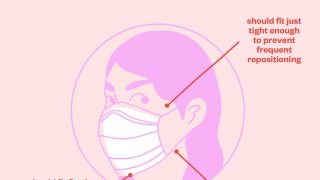
Unless you work in the medical field, odds are you've never had much of a reason to wear a face mask before. But in the era of coronavirus, protective face masks are recommended and have become the new normal.
TODAY enlisted the help of medical experts to break down some of the most common mistakes many of us make while wearing face masks. From tricks for keeping your mask clean to tips for getting the best fit possible, consider this your go-to guide for making the most of your protective face mask.
Cover your nose and mouth
Face masks are one way to protect yourself and others from the spread of coronavirus, but they're only effective when worn properly. So when you put one on, make sure it covers the most vulnerable spots on your face: the nose and mouth.
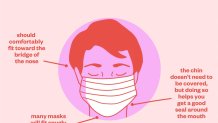
"These are the areas where virus can be shed from. Masks should comfortably fit toward the bridge of the nose," Dr. David M. Aronoff, director of Vanderbilt University Medical Center's Division of Infectious Diseases, told TODAY Style.
Depending on the shape of your nose, your mask might lie a bit above or below this spot. The key, according to telemedicine doctor and autoimmune disease specialist Dr. Brooke Goldner, is to make sure the majority of your nose and your entire mouth is covered.
"The positioning on the nose might vary depending on the shape of your nose, so the position should be the spot where there is the best seal around your nose and mouth. For most people, that is the very top of your nose below your eyes," Goldner said.
Face masks that are big enough to shield your chin are great, but not necessarily essential. "The chin does not need to be covered but it is easier to get a good seal around the mouth if the chin is used to support (it), so many masks will fit snugly on the chin," Aronoff said.
It should fit snugly, but comfortably
Wearing a mask takes some getting used to, but it should never restrict your ability to breathe.
"The mask does not need to be uncomfortably tight, but you do want to make sure there are no gaps between your face and the mask," Goldner said.
Small gaps are normal and unavoidable, but the fewer there are and the smaller they are, the better. That's because your face mask should form a protective shield around your face.
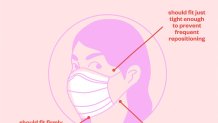
"When you inhale, air will try to find the path of least resistance to get into your body. If there are gaps between your face and the mask, the air will go around the mask rather than through it, therefore negating the benefits. The goal is for the air to go through the mask, not around it, to filter the air before you breathe it in," Goldner said.
Ensuring a proper fit can also help you avoid frequently readjusting your mask, which can lead to cross-contamination.
"In general, a mask is less helpful or counterproductive if it is not covering the nose and mouth — such as worn down around the neck for extended periods of time or if it is poorly fitting to the point that it requires frequent adjustment, which brings your hands close to your face repeatedly," said Dr. George Anesi, director of the Medical Critical Care Bioresponse team at Penn Medicine.
Wash your hands before and after wearing a mask
Putting a clean, protective face mask on isn't helpful if you touch the inside of it with dirty hands. So the key to keeping your face mask as sanitary as possible is to wash your hands for 20 seconds with soap and water (or use an alcohol-based sanitizer) before putting it on. You should also pick it up by the ties to do so.
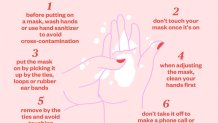
Once the mask is on, the next task is preventing cross-contamination while you're out and about.
"Cross contamination occurs when someone touches under their mask or touches someone or a surface (a door handle, a box or can in the grocery store) and then touches their mask. Don’t reach for a product in the store and then reach up and adjust your mask. Avoid reaching under your mask if you have an itch," Dr. Ruth L. Bush, associate dean of medical education and a professor at the University of Houston College of Medicine, said.
If you absolutely have to adjust your mask while wearing it, make sure to clean hands with sanitizer or soap and water. It's best to avoid touching your phone while you're wearing a mask and gloves, but if you have an urgent phone call to make, use the speaker to avoid touching the phone/your hands to the mask, then disinfect the phone.
When it's time to remove the mask, sanitize your hands again before loosening the ties, loops or rubber ear bands. "Try to avoid touching the outside of the mask and fold it on itself with the outside in for storage. It can be stored in a paper bag," Anesi said.
And, of course, wash your hands again after removing your mask.
Clean your cloth mask regularly
It's fairly difficult to get your hands on a disposable mask these days and N95 masks should be reserved for health care workers, so many of us are turning to cloth masks. Whether you've created your own or purchased one online, cloth face masks should be regularly cleaned, ideally after each use.
"A washing machine on the hot water setting with your normal detergent should be sufficient for cleaning your mask," said Dr. Edo Paz, VP medical at primary care service K Health.
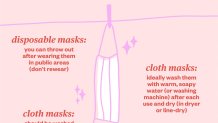
Once clean, thoroughly dry the mask (in a dryer or on a clothes line) before putting it back on your face. To avoid contaminating your freshly cleaned mask, try to keep it away from common surfaces around the house and store it in a paper bag, avoiding plastic bags and containers that lock in moisture.
If you're using a disposable face mask, the guidelines for cleaning are slightly different.
"Disposable masks can likely be used all day in public areas (not including high-risk clinical areas), but should not be reused on another day unless they were used very briefly or can be sanitized or cleaned in some way. It is recommended to look up information on cleaning or sanitizing commercially available disposable masks with the manufacturer," Aronoff said.
Once you're done using a disposable mask, wash your hands and remove the mask using the ties then discard it in a trash bin.
Masks aren't the only way to protect yourself and others
Wearing a mask when you leave the house for an essential trip outside is now widely recommended, but it's not the only way to help slow the spread of coronavirus. In order to protect yourself and others, you should still follow social distancing guidelines.
"Protective equipment, such as masks and gloves, can create a false sense of security, which leads people to be less careful and intentional about what they touch and their hand washing or (lead them to) not pay attention to social distancing," Goldner said.
In other words, just because you have a few face masks at home doesn't mean you should start leaving the house more often.
"A mask can be used to reduce the risk of transmission to others ... during essential public activities. A mask should not be used to justify additional or nonessential public activities. Continued social distancing is the most effective tool we have to end this pandemic," Anesi said.
This story first appeared on TODAY.com. More from TODAY:

